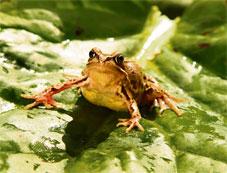A bright future

Can you predict the weather from the colour of a frog's skin? Éanna Ní Lamhna investigates
It's always amazing to me when people tell me they have seen a frog in their garden when they live nowhere near a pond. Not amazing that they should have seen the frog, but that they expect frogs to live only in ponds. After all, these creatures are amphibians, not fish, and they spend most of their lives on land, not in ponds.
In February and March – mostly February this year since Spring came early – frogs wake from hibernation, congregate at the nearest pond and noisily proceed to ensure that the species survives extinction for another year. You read all the gory details in this column last year and have no doubt witnessed those very actions in a pond near you. So by this stage, the ponds are full of newly-hatched tadpoles eyeing each other up cannibalistically, as a weaker sibling can provide a fine meal when times get tough. But Mammy and Daddy are no longer hanging about. They are not keeping a watchful eye over their progeny. They have done their bit in that department for this year.
The adult frogs disperse when the mating season is over to the surrounding grasslands, woodlands, ditches and hedgerows. This is where they will spend the next eight months, feeding on insects like flies, caterpillars, beetles and invertebrates like woodlice, centipedes, spiders, snails and slugs in particular. Gardeners will be interested to know that the record for mollusc-eating among frogs is held by a frog from Land's End in Cornwall who was discovered to have eaten 18 slugs in one single night.
So gardens are their preferred habitat – they only visit ponds to mate. Unlike humans, frogs are not at it all the time so they don't need to live their lives by a pond. Adults can live for up to 12 years. If your garden has a bit of cover such as a patch of long grass or an abandoned piece of carpet which can provide shelter for the frog on the hottest part of the day, you will find them there.
The colour of frogs is another source of wonder. Perfectly normal frogs can vary in colour from practically black to light yellow. The old wives take this as a forecast of what the weather will be like in the coming period. Can this be true? Is there any scientific reason for it?
Frogs have three layers of pigment in their skin. The upper layer contains yellow pigments, the middle ones have white crystals and the deepest layer contains dark melanin pigments. Green and blue skin colour is caused by light rays that pass through the epidermis and are reflected back by these layers of pigments. So all these ingredients can give rise to quite a variety of colours in the same individual frog, depending on the environmental circumstances. Dryness, light and high temperature induce a light colour, while moisture, darkness and low temperature induce a dark colour.
So if you see a dark coloured frog, it has been hiding away because the weather has been cold and wet. Its colour tells us what the weather has been like rather than forecasting what it will be like. And if it has been warm and dry long enough for the frog to have changed to a pale yellow colour, well then there's probably a ridge of high pressure in and we are in the midst of a spell of good weather. As usual, there is a grain of truth to the old wives' tale.
So there is no reason for amazement if you find frogs in the garden. That's where they are supposed to be, munching merrily on snails and slugs and acting as mini-weather forecasters.
